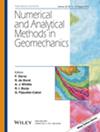边坡稳定性分析:采用离散破坏机制和水平片极限平衡法
IF 3.6
2区 工程技术
Q2 ENGINEERING, GEOLOGICAL
International Journal for Numerical and Analytical Methods in Geomechanics
Pub Date : 2025-06-11
DOI:10.1002/nag.4020
引用次数: 0
摘要
边坡安全系数是评价边坡稳定性的重要指标之一。为了更合理地计算边坡的安全系数,本文提出了一种将离散破坏机制与水平切片法相结合的新方法。该方法利用离散技术生成潜在滑动面,通过水平切片法计算特定滑动面的安全系数,然后将边坡稳定性分析转化为一个三参数优化问题,利用全局优化算法(灰狼优化器)快速求解。静、动态条件下的算例表明,与强度折减法和Morgenstern-Price法计算的安全系数相比,该方法计算的安全系数相对误差小于2%,且临界滑动面对齐良好。在复杂的真实世界的边坡场景中,与Morgenstern-Price方法相比,使用所提出的方法确定的临界滑动面与通过强度折减方法获得的结果更接近。参数分析表明,土体单位重量的增加导致滑面最大深度略有减小。最大深度对水平地震系数的敏感性大于对土体强度参数的敏感性;随着地震系数的增大,滑移面明显加深。所提出的方法很容易扩展到准动态分析模型,允许更准确地评估地震效应,并显示出相当大的可扩展性。与现有的切片法相比,所提出的方法不仅简单,而且合理地考虑了边坡岩土参数的非均质性,使其成为分析边坡稳定性的潜在有价值的工具。本文章由计算机程序翻译,如有差异,请以英文原文为准。
Slope Stability Analysis: Implementing Discrete Failure Mechanisms and Horizontal Slice Limit Equilibrium Method
The safety factor of a slope is one of the most important indicators for evaluating slope stability. To more reasonably calculate the safety factor of slopes, this paper presents a new method combining discrete failure mechanisms and a horizontal slice method. This approach generates potential sliding surfaces using discrete techniques, calculates the safety factor of specific sliding surfaces via the horizontal slice method, and then transforms the slope stability analysis into a three‐parameter optimization problem, which is solved quickly using a global optimization algorithm (gray wolf optimizer). Cases under static and dynamic conditions show that the safety factor calculated by this method has a relative error of less than 2% compared to those calculated by the strength reduction method and the Morgenstern–Price method, with the critical sliding surfaces also aligning well. In complex real‐world slope scenarios, the critical slip surface identified using the proposed method more closely aligns with that obtained via the strength reduction approach than with the Morgenstern–Price method. Parametric analysis indicates that increasing the soil unit weight leads to a slight decrease in the maximum depth of the slip surface. The maximum depth is more sensitive to the horizontal seismic coefficient than to soil strength parameters; as the seismic coefficient increases, the slip surface deepens markedly. The proposed method is readily extendable to quasi‐dynamic analytical models, allowing for more accurate assessment of seismic effects and demonstrating considerable scalability. Compared to the existing slice method, the proposed method not only ensures simplicity but also reasonably accounts for the heterogeneity of the geotechnical parameters of the slope, making it a potentially valuable tool for analyzing slope stability.
求助全文
通过发布文献求助,成功后即可免费获取论文全文。
去求助
来源期刊
CiteScore
6.40
自引率
12.50%
发文量
160
审稿时长
9 months
期刊介绍:
The journal welcomes manuscripts that substantially contribute to the understanding of the complex mechanical behaviour of geomaterials (soils, rocks, concrete, ice, snow, and powders), through innovative experimental techniques, and/or through the development of novel numerical or hybrid experimental/numerical modelling concepts in geomechanics. Topics of interest include instabilities and localization, interface and surface phenomena, fracture and failure, multi-physics and other time-dependent phenomena, micromechanics and multi-scale methods, and inverse analysis and stochastic methods. Papers related to energy and environmental issues are particularly welcome. The illustration of the proposed methods and techniques to engineering problems is encouraged. However, manuscripts dealing with applications of existing methods, or proposing incremental improvements to existing methods – in particular marginal extensions of existing analytical solutions or numerical methods – will not be considered for review.

 求助内容:
求助内容: 应助结果提醒方式:
应助结果提醒方式:


